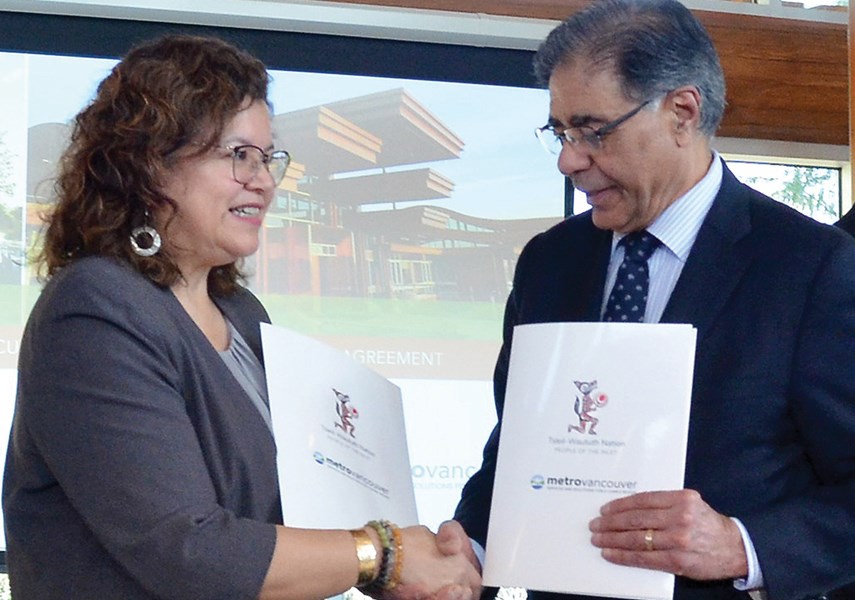Metro ┬щ╢╣┤л├╜╙│╗нand the Tsleil-Waututh Nation announced an agreement Tuesday afternoon that will pave the way to co-operative management of Belcarra Regional Park.
The agreement, signed in North Vancouver, recognizes the Metro regional park as the largest ancestral home of the Tsleil-Waututh in the past, with ongoing cultural importance.
The agreement states that Metro and the Nation will work together to protect and preserve the park for future generations.
While the deal doesnтАЩt set out specific actions the Tsleil-Waututh will be involved in, it ensures the nation will be consulted and involved, and that the nationтАЩs historical presence on the land will be recognized, said Ernie George, CAO of the Tsleil-Waututh Nation.
тАЬIt puts the Tsleil-Waututh on the ground,тАЭ said George.
Traditionally, the area where the park sits тАУ known as t╔Щmt╔Щmix╩╖t╔Щn or Tum-tumay-wa-ton by the Tsleil-Waututh тАУ was the largest village of his people, said George, where many families would spend the winter in longhouses. In spring, those families would typically travel to other villages throughout Burrard Inlet and Indian Arm.
тАЬItтАЩs about having a seat at the table and being heard,тАЭ as well as educating others who visit the park and live in the area about the importance that the area holds for the Tsleil-Waututh, said George.
And for the First Nation thatтАЩs most closely associated with the North Shore, itтАЩs a chance to highlight its roots on the other side of Burrard Inlet.
тАЬTsleil-Waututh means тАШpeople of the inlet.тАЩ It doesnтАЩt mean the North Shore. It means тАШof the inlet,тАЩтАЭ said George. тАЬItтАЩs not a big distance. All of our village sites always interacted. The inlet was our highway.тАЭ
тАЬItтАЩs a great opportunity for Metro ┬щ╢╣┤л├╜╙│╗нand the Tsleil-Waututh to understand each otherтАЩs values and what weтАЩd like to see in the park,тАЭ he added.
The agreement formalizes a co-operative relationship that has been in place for several years.
For instance, Metro ┬щ╢╣┤л├╜╙│╗нand the Tsleil-Waututh worked together on recent plans for a picnic area at the park.
Sav Dhaliwal, board chair of Metro Vancouver, described the agreement as тАЬhistoricтАЭ and possibly the first of many the regional government intends to enter into with other Coast Salish people regarding cultural co-operation in regional parks.
Dhaliwal said the agreement was open-ended, with no specific terms about what kind of cultural sites or activities would be considered.
тАЬThey are the stewards of this land. WeтАЩll work with them,тАЭ said Dhaliwal.
George said the Tsleil-Waututh anticipate the agreement working in a similar fashion to the way an agreement with the District of North ┬щ╢╣┤л├╜╙│╗нgoverns co-management of Cates Park/Whey-ah-Wichen in North ┬щ╢╣┤л├╜╙│╗нand an agreement with the province covers the Say Nurth Khaw Yum/Indian Arm Provincial Park in Indian Arm.
According to Metro Vancouver, the 1,100-hectare Belcarra Regional Park тАУ directly across Burrard Inlet from the present-day home of the Tsleil-Waututh in North ┬щ╢╣┤л├╜╙│╗нтАУ attracts more than one million visitors every year, who enjoy a popular beach, hiking trails and seasonal swimming in Sasamat Lake.
Metro VancouverтАЩs regional parks system now includes 13,600 hectares of park land, including 23 regional parks, two ecological conservancy areas, two regional park reserves and five greenways.
тАУ with files from Steffan Labb├й, Tri-City News



